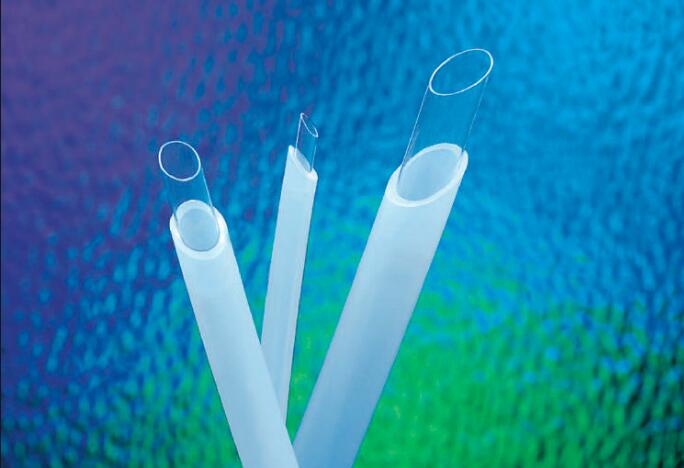| Property | Method No. | Units | PTFE | FEP | PFA | ETFE | ECTFE | PCTFE | PVDF |
| Specific Gravity | D792 | – | 2.17 | 2.15 | 2.15 | 1.74 | 1.7 | 1.7 | 1.78 |
| Melting Point | D2236 | deg F deg C |
621 327 |
518 270 |
581 305 |
527 275 |
464 240 |
410 210 |
352 177 |
| Tensile Strength | D638 D1708 D1457 |
psi MPa |
2500 17 |
3400 23 |
4,000 27 |
6,960 48 |
6,960 48 |
6,060 41.78 |
7,830 54 |
| Yield Strength | D638 | psi | 1,450 | 1,740 | 2,250 | 3,480 | 4,500 | 5,800 | 6,670 |
| Elongation | % | 200-500 | 250-350 | 300 | 200-500 | 200-300 | 80-250 | 20-150 | |
| Tensile Modulus | D638 | ksi | 87 | 72.5 | 101.5 | 217.5 | 240 | 218 | 348 |
| Flex Modulus | D790 | psi x 1000 MPa |
98 675 |
101.5 700 |
95 655 |
203 1400 |
261 1800 |
– | 333.5 2300 |
| Izod Impact | D256 | ft-lbs/in J/m |
3.2 173 |
No Break | No Break | No Break | – | – | 2-4 |
| Hardness | D2240 | Shore D | 60 | 57 | 62 | 75 | 75 | 90 | 79 |
| HDT, @ 66 psi | D648 | deg F | 250 | 158 | 164 | 219 | 240 | 248 | 300 |
| HDT, @ 264 psi | D648 | deg F | 122 | 129 | 118 | 160 | 169 | – | 239 |
| Max. Cont Use Temp | deg F deg C |
500 260 |
400 204 |
500 260 |
300 149 |
||||
| *Flame Rating | UL 94 | VO | VO | VO | VO | ||||
| Limiting Oxygen Index | D2863 | % | >95 | >95 | >95 | 30-36 | |||
| Thermal Conductivity | Btu·in/h·ft2·°F W/m·K |
1.7 0.25 |
1.4 0.20 |
1.3 0.19 |
1.65 0.24 |
||||
| Dielectric Constant | D150 | 1 MHZ | 2.1 | 2.1 | 2.1 | 2.6 | |||
| **Dielectric Strength | D149 | Volts/µm | 18 | 53 | 80 | 79 | |||
| Resistivity – Volume | D257 | ohm-cm | >1018 | >1018 | >1018 | >1017 |
PTFE Properties:
The Steel Industry and Chemical Processing Industry have been using fluoropolymer tubing products from materials like PTFE and hoses for many years for transferring highly caustic or corrosive chemicals. More and more, PTFE tubing is replacing carbon and other metal piping that deteriorates rapidly. Now and for the future, PTFE will continue to serve the industry in critical applications.
PTFE Thermal Qualities:
PTFE tubing can withstand temperatures up to 680 °F for limited periods of time.* Under cryogenic conditions, PTFE remains strong down to -320 °F.
*Above 500 °F, mechanical properties become a limiting factor
PTFE Electrical Qualities:
PTFE tubing has superb electrical properties, indicated by a low dielectric constant of 2.1 between -40 °F and 480 °F within a frequency range of 5 Hz to 10 GHz.
PTFE tubing is also an excellent insulator with surface resistivity of 3.6 X 1012 ohms (even at 100% relative humidity).
Short time dielectric strengths range from 500 volts/mil (1 mil = 10-3 in) for thicknesses greater than 100 mils to 4000 volts/mil for very thin films.
FEP Properties:
Electrical FEP exhibits most of the properties of PTFE. However, because of its excellent electrical FEP properties, FEP tubing is a valuable and versatile electrical insulator.
Chemical FEP tubing is inert to most chemicals and solvents, similar to PTFE
Weathering FEP tubing products are virtually unaffected by weather elements. Its resistance to extreme heat, cold, and UV radiation further suits FEP properties for electronic applications.
ETFE Properties
ETFE is distinguished from perfluopolymers (totally fluorinated polymers) as a partially fluorinated copolymer of ethylene and TFE. This chemical modification provides significantly higher strength relative to PTFE, FEP or PFA. It is less flexible than PTFE, but has superior impact strength, abrasion and cut through resistance. Addition of a third component to the chemical structure creates a modified ETFE that has lower weight per unit volume, is stiffer and tougher than PTFE, PFA or FEP. These properties allow it to withstand greater physical abuse during its lifetime. For example, glass reinforced ETFE has outstanding wear characteristics and may be used for bearing applications. ETFE is also suitable for pump impellers or moving parts of equipment that are operating in chemically aggressive environments (check to ensure chemical compatibility).
PVDF Properties
PVDF (KYNAR®) is generally used in applications requiring the high purity, strength, and resistance to solvents, acids, bases and heat. Compared to other fluoropolymers, like PTFE, PFA, FEP, it has an easier melt process because of its relatively low melting point of around 177°C.
PCTFE Properties
PCTFE or CTFE (originally known as Kel-F*) has many of the properties similar to other fluoropolymers such as PTFE, FEP or PFA, but is mechanically superior in rigidity (does not deform easily), and has very low gas permeability . Its dimensional stability makes it attractive for use as a component of a structural part where the high temperature and chemical resistance of fluoropolymers is required. PCTFE shows high compressive strength and low deformation under load. However, its relative cost is one of the major considerations in its selection, since it is quite expensive.





Interested in HARD ROCK? How about Kiss band? They are on a tour at the moment all across the US&Canada. Click on KISS Tickets Atlanta to know more about KISS tour in 2019.